The post Electric Scooters for Beginners: Everything You Need to Know Before You Buy! appeared first on eRide Guides.
]]>In 2020, it’s not uncommon to see e-scooters existing with traditional, human-powered scooters, bicycles, or skateboards.
Dissecting what makes an e-scooter unique from its analog variety doesn’t have to be complicated. In fact, they operate in a similar way to scooters you’ve used as a child. With an added motor, battery, and throttle, you can exceed speeds of 20 mph (32 km/h) easily.
If you’re interested in picking up an electric scooter, this article will act as an introduction.
But first, we need to establish what an e-scooters is before discussing its laws, components, maintenance, and more.
What is an Electric Scooter?
First, let’s look at what makes an electric scooter unique from its traditional human-powered model. To put it plainly, and an electric scooter is a regular scooter with an electrical drive system.
This consists of a battery, motor, and a way to control it. E-scooters, unlike e-bikes, do not have drivetrains because there are no pedals to move the mechanism.
The SmartKick X8 has all the components of a traditional e-scooter:
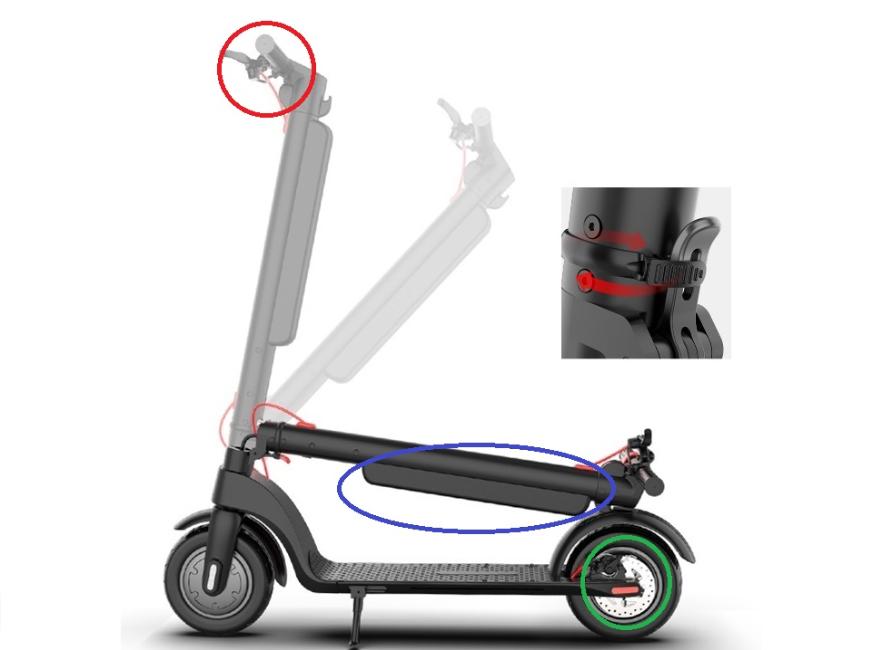
Photo Courtesy: Kat Dent/Smart Wheel
- Blue Circle: The battery that powers the motor sits on the stem.
- Red Circle: The throttle, which controls the power, is similar to a motorcycle handle.
- Green Circle: Mid-drive motor helps to propel the e-bike forward. Some e-scooters have motors in both wheels, while others have it in one like the scooter pictured.
These three critical components set the e-scooter apart from the human-powered scooter. Once you remove these components, the scooter becomes analog and must be pushed by your legs off of the ground.
What is the Difference Between an E-Scooter and a Motorcycle?
Although there are many similarities between an electric scooter and a motorcycle, they are entirely different from one another. The most significant difference is what powers the motorcycle.
Typically, motorcycles use gas because this fuel offers an unlimited range. Motorcycles can also keep up with highway traffic, and have room for a passenger.
As a disadvantage, motorcycles are more expensive, have loud motors, and are costly to maintain. Motorcycles take up a significant amount of space, as well.
E-scooters cost much less than motorcycles, even when compared to the initial price of the purchase, maintenance, and an expensive battery or motor replacement.
E-scooters are quiet and often fold so small and compact that they can fit in a backpack. You will miss out on the motorcycles’ cool’ factor because scooters are often associated with children’s toys.
If you’re on the market for a lightweight, foldable and compact mode of transportation with no rules or regulations, an e-scooter is the perfect vehicle for you. However, if you want to go faster, drive long distances, and have better visibility and suspension, a motorcycle will suit your needs.
What is the Difference Between an E-Scooter and a Moped?
Electric scooters are often compared to mopeds because of their similar (but bigger) design. Mopeds are gas or electric scooters with a platform for the user’s feet and a step-through base. Some are so big that they are often classified as “power-assisted bicycles” or motorcycles.
Despite how similar they are, mopeds and e-scooter have a few differences that set them apart. First, mopeds are more prominent and clunkier and must be operated on roads or European style wide sidewalks. Mopeds also require a driver’s license, registration, and insurance in most US states, whereas the e-scooter doesn’t.
In the United States, mopeds are made too big and broad to fit on the sidewalks (although some still try to – mopeds aren’t really regulated). E-scooters can function adequately on either the sidewalk or road as long as they’re fast enough to keep up with traffic.
Mopeds and e-scooters can’t ride anywhere but in the city, and both aren’t capable of riding up a mountain with the motor alone. However, an e-scooter is still capable of being carried up a mountain or kicked up if necessary.
How do E-Scooters Work?
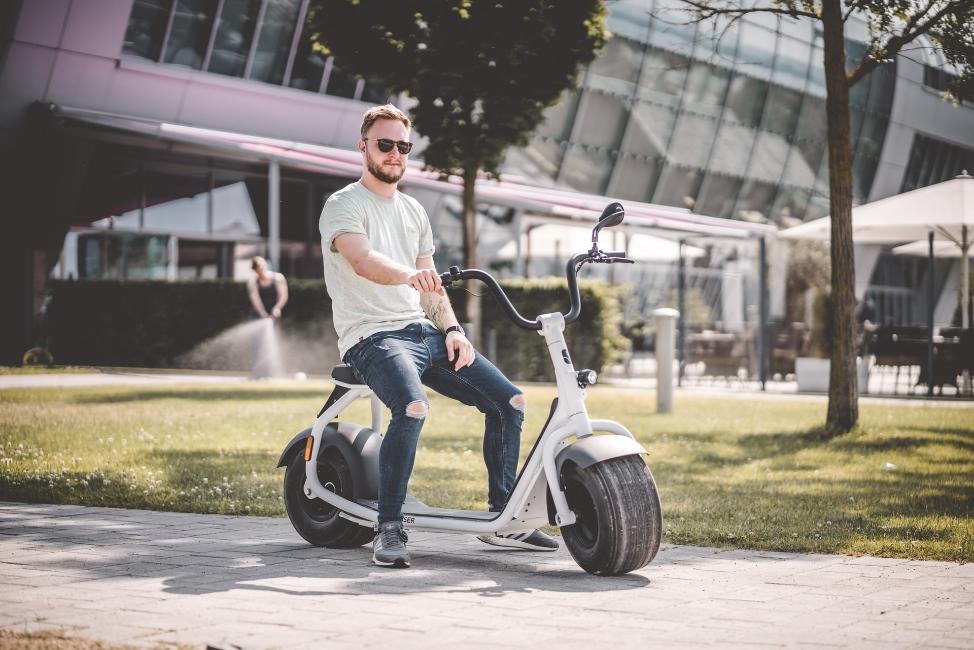
Photo Courtesy: Kumpan Electric/Unsplash
Mid-Drive
The electric mid-drive motor in an e-scooter creates an effortless riding experience fro the user. Although mid-drive motors are standard, hub motors are also found in e-scooters, although they don’t perform as well. Mid-drive motors take advantage of the guards to drive the crank and amplify the scooter’s powers.
On an e-scooter, the motor is located in one or more of the wheels, depending on the model. Keeping the motor close to the ground improves the center of gravity, which distributes the weight evenly throughout the scooter.
Battery
Electric scooter battery packs are made up of multiple individual cells that are assembled together. They store the energy that is consumed by the mid-drive or hub motor and other accessories like the lights.
Lithium-ion battery cells are the most common, although some kids’ models will use lead-acid batteries.
Batteries are rated in watt-hours (Wh) to measure capacity, and Wh is an essential factor in determining range. The typical scooter will range from 250-750 watt-hours, which could have a range of 20 mph (32 km/h), 25 mph (40.23 km/h), or 28 mph (45 km/h).
Throttle
Throttles are standard in most electric vehicles, including e-bikes and motorcycles, and they serve the same purpose. When the user turns the accelerator, the motor kicks in and lets you control the speed.
When you turn the throttle forward, the e-scooter will start to drive. The speed of the scooter is determined by how far forward the user turns the throttle.
Along with the accelerator, the brakes, power buttons, speed, and setting displays are also located in various places along the handlebars. Most portable e-scooters have folding handlebars as well, which can help with storage.
Not all e-scooters are made the same, but they all have these 3 components. Most electric scooters came with suspension, brakes, and lights.
How do you Ride an E-Scooter?
Electric scooters operate similarly to many electric vehicles (bikes or skateboards) in that they add a motor to assist propulsion. To ride an electric scooter, simply put your feet on the deck and pull the throttle forward.
Some electric scooters are seated. These are mostly for adults who prefer to make longer rides more comfortable. If your e-scooter doesn’t come with a seat, many can be fitted for one and are sold as a separate accessory.
If the motor runs out, you can push the scooter with your legs on the ground like an analog scooter. Since most batteries are small and detachable, it’s easy to recharge your battery within a few hours – so this is unlikely to occur.
Most e-scooters have either option (to use the throttle or kick manually). This is perfect for office workers who want to arrive at the job without sweating through their clothes. At the same time, an office worker can fold their e-scooter into a backpack or under their desk for easy storage.
Common Features of an E-Scooter

Photo Courtesy: Kenny Luo/Unsplash
Besides the battery, motor, and throttle, many other features come with the typical e-scooter.
Folding
Most electric scooters are able to fold completely in half so you can store them securely in your car, within your home, or on public transport.
If you often take detours in a subway or on an Uber, or you live in a bachelor or small apartment – pick a folding scooter. Folding e-scooters are often lighter, but it’s rare to find a scooter that doesn’t fold, anyway.
Braking System
A quality braking system, such as disc brakes, is essential to stay safe and in control while riding. Brakes can either be electronic or manual, where electric relies on the motor and mechanical relies on a physical mechanism.
Mechanical brakes offer a stronger system, but often e-scooters will use both in case one fails.
Controller
A speed controller sends power to the motor based on individual accelerator input. The controller receives inputs from the accelerator and brake controls and translates this current to the motor. Controllers are rated based on voltage and current to regulate, and they are responsible for most of the power that the e-scooter uses.
Deck
Similar to a skateboard deck, the deck on an e-scooter is the place where yous stand while riding. Rubberized nubs will line the deck for better traction. Some kick scooters will have a wider space for your feet, but a common deck size is usually 14″ by 5″ inches and gives you a few inches for ground clearance.
Stem
The stem is the tube that connects the metal casing to the handlebars. The folding mechanism is usually located on the stem for easy carrying and storage. Before purchasing a scooter, shake the stem back and forth to make sure it doesn’t collapse while riding.
It’s possible for the stem to wobble if the folding mechanism is poorly installed.
Electronic Panel
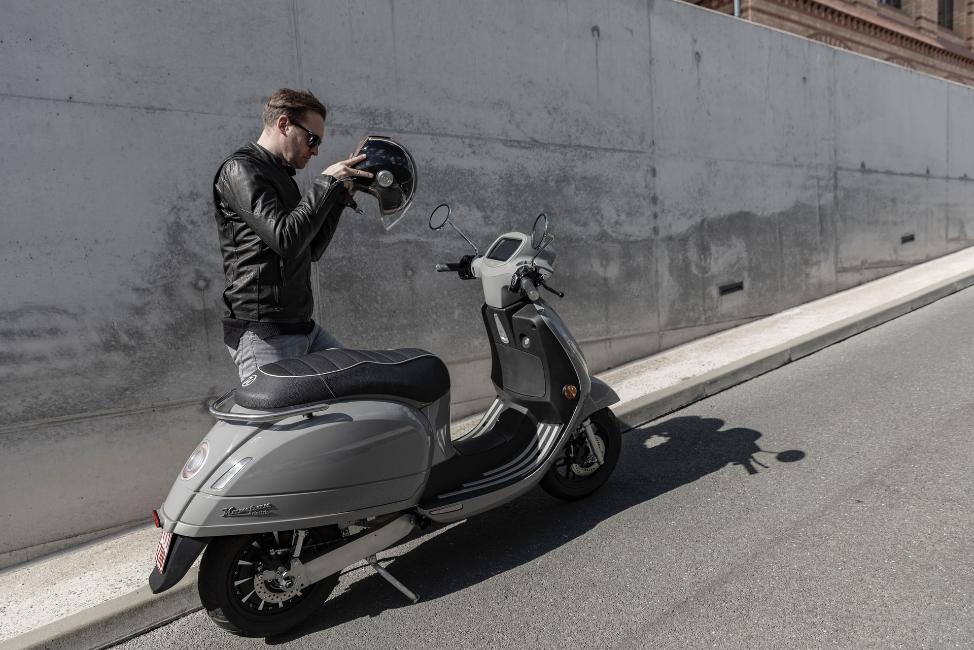
Photo Courtesy: Kumpan Electric/Unsplash
It’s common for an electric scooter to have a panel display, even though it isn’t necessary for the full experience. Electronic panels will display headlights, distance, power status, speed, PAS grades, and error messages.
A battery level display, included in most electric panels, is beneficial on short-range scooters that could run out of charge quickly.
Range
All e-scooters have a set range based on the batteries wattage. The range depends on the type of riding you’re doing (up a slight hill or city riding), so it’s difficult to put a proper range length as a selling point.
Most manufacturers assume you’ll ride on a flat sidewalk because e-scooters aren’t meant for uphill or mountain riding.
To calculate the watt hours (range) of a battery pack, multiply the voltage by amp hours. A 36-volt 10-Ah battery pack has 360-watt hours (36 X 10 = 360). Each mile costs 20-watt hours on average. Therefore, a 360-watt hour pack will get you 18 miles on one charge.
Suspension
May electric scoots have no suspension, but some expensive models will have coil-over-hydraulic suspension. There are three main suspension systems in an e-scooter: hydraulic, spring, and air piston.
The best suspensions will have a combination of sping and piston, but most scooters will us large pneumatic tires instead.
Tires
Tires help with traction and have internal braking mechanisms that activate in case of an emergency. Airless tires require no air maintenance, but pneumatic tires are better for their traction, ride quality, range, and performance.
If you have purchased a scooter without a decent suspension system, always opt for pneumatic tires.
Common Accessories for an E-Scooter
If you’re thinking about adding some accessories to your e-scooter, consider these items that can improve your safety while also helping you stand out from the crowd.
- Helmet: Safety is no joke – you could be maimed or killed from riding an electric scooter. Since e-scooters exceed 20 mph (32.19 km/h), it’s essential to wear a DOT-approved motorcycle helmet just increase of an accident.
- Side Mirrors: Unless you’ve purchased a $1000 e-scooter, they won’t come with mirrors even though they’re essential for your safety. You can equip a set of mirrors on your handlebars to increase your visibility.
- Lights: Don’t ride at night if you don’t have lights attached to the front and back of your scooter. If your e-scooter comes with front lights, equipt taillights so vehicles can see you in an alleyway or on a dark country road.
- Basket: Although e-scooters are often small, you can equip a deep basket that runs the length of the stem for groceries. Adding a basket helps to remove the likelihood of your back getting sweaty if you wear a backpack during commutes.
We also encourage you to get grips for your handlebars for a more comfortable riding experience. An extra seat may also be ideal for you if you plan on taking long trips. Always buy scooter tools for standard repair and maintenance jobs.
Growing Popularity of E-Scooters

Photo Courtesy: Nick Belanger/Unsplash
According to the Global E-Scooter Market projections for 2020-2024, the growth rate is expected to increase by 5.94% each year. On average, the e-scooter market is expected to grow by 2,138.50 thousand units in the next 4 years.
This is attributed to the increase in pollution and traffic congestion that is driving consumers to choose electric transportation.
The development of high-performance e-scooters is one of the reasons why market trends are seeing a growth in the market.
The decline in battery prices, increasing awareness of the technology, and the low operating cost make e-scooters affordable to many Americans, and many large retailers like Suzuki Motor are taking notice of this trend.
A senior analyst at Technavio stated: “Factors such as the emergence of connected e-scooters and established two-wheeler OEMs venturing into global electric two-wheeler market will have a significant impact on the growth of the e-scooter market value during the forecast period,”
Technavio, a global technology research and advisory company, researches emerging marketing trends. They assume that e-scooters will be on the rise indefinitely.
Laws and Regulations
E-scooters aren’t as regulated as other electric vehicles (like the e-bike), but in general, they are considered illegal in all US states. Most jurisdictions regulate them like bicycles, as they can be ridden on the street or bike lanes.
Since there are very few regulations associated with e-scooters, it’s better to review individual state laws before operating. You will not need a license or any special insurance to ride an e-scooter, although coverage is available if needed. Be sure to follow and obey all traffic laws, like stopping at a red light or turning left on a green light.
Speed and Kicking
The speed of an e-scooter depends mostly on price rather than other factors such as Class on an e-bike. Most e-scooters will range from 20 mph (32.19 km/h) to 28 mph (45 km/h). Anything faster isn’t considered illegal because e-scooters aren’t as regulated.
| Battery + Motor (Flat Terrain 165 lbs Male) | Max Speed | Average E-Scooter Cost | Average Charge Time |
| 250w | 20 mph (32.19 km/h) | $500 – $1000 | 20 minutes |
| 500w | 25 mph (40.23 km/h) | $750 – $1250 | 40 minutes |
| 750w | 28 mph (45 km/h) | $750 – $1500 | 60 minutes |
| 1000w | 35 mph (56.32 km/h) | $1000 – $1500 | 80 minutes |
| 1500w | 40 mph (64 km/h) | $1500 – $2000+ | 120 minutes |
E-scooters have the option of turning into kick scooters, but they won’t provide any extra speed. In fact, they will slow down your e-scooter and/or case the braking mechanism to kick in for safety reasons. It’s better just to use the throttle.
Safety Tips
E-scooters provide a great way to get around the city. Although they are considered relatively safe, e-scooters require attention to ensure your commute doesn’t become dangerous. Many electric scooter safety tips apply to traditional scooters, bicycles, and other motorized vehicles.
- Wear A Proper Helmet
- Use Both the Tailights and Headlights
- Use a Bell or Horn to Warn Others
- Never Ride Against Traffic
- Avoid Sidewalks if Possible
- Keep Pneumatic Tires From Deflating
- Use Defensive Driving Techniques
- Install and Use Your Mirrors
Even though scooters aren’t regulated or require a license to operate, it’s never okay to drive drunk. It’s possible to get seriously injured if you aren’t aware of your actions. Instead, fold your e-scooter, place it in an Uber, or walk home.
Insurance
Property insurance (renter or homeowner condo insurance) usually includes liability protection. This means that if someone gets hurt, or has their property damaged or destroyed in an accident, that liability insurance should help cover your expenses.
This can also include damages defense costs settlement and judgment awards.
You must report any damage you see on your e-scooter to the insurance company, as the manufacture will usually cover general wear and tear. However, if the cost goes beyond the damage of your scooter, you likely won’t be covered by insurance.
Most insurance won’t cover medical expenses, but your health care provider will likely supplement that cost. Liability coverage in your home and auto insurance is tailored towards injuries to others, so insurance won’t cover you in this situation.
Although insurance does exist, it’s a lot more prevalent in Europe and Canada than it is in the United States. You may have to get bicycle insurance that includes other motor vehicles. To see what in-depth coverage looks like, visit this insurance company based out of Alberta, Canada.
Average Lifespan
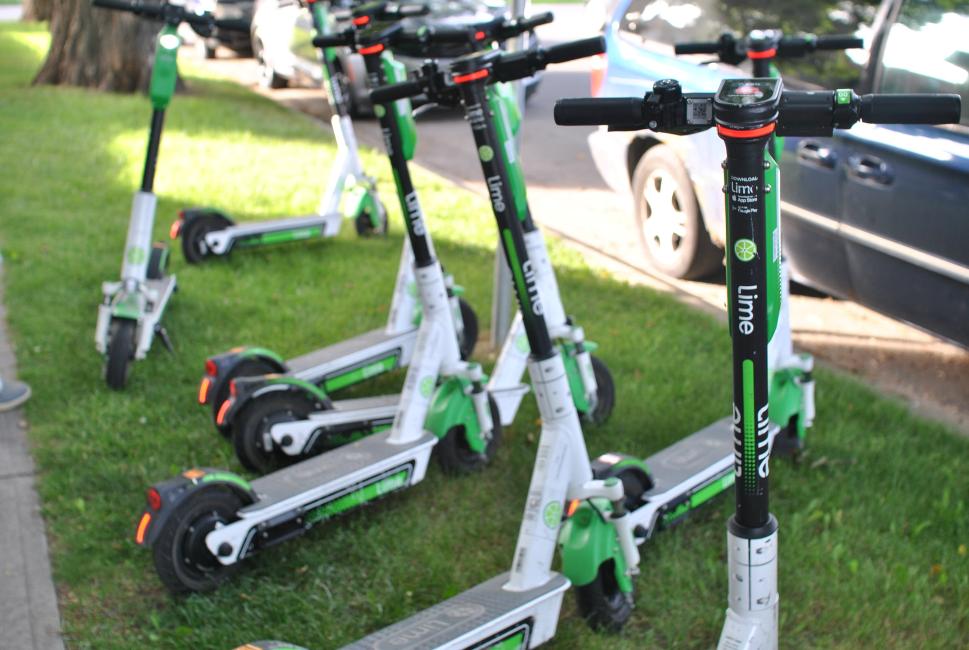
Photo Courtesy: Zera Li/Unsplash
Privety-owned e-scooters with proper maintenance and care will last at least 2-3 years, and likely much longer than that. Rideshare electric scooters will only last 1-5 months, but that is likely due to the mistreatment of the device itself.
If you treat your e-scooter correctly, you could see 7 years or longer.
Privately-owned e-scooters aren’t often dumped, so people likely continue to fix them for as long as possible. Individual parts that tend to break are the battery, front and rear lights, tires, and the rear fender.
If you focus your time on maintaining these parts, you’ll likely have an e-scooter that lasts a very long time.
Maintenance
Schedule A Weekly Cleaning: Keep your e-scooter clean as often as possible to dirt, debris, and dust don’t make their way into the engine. Never use a pressurized hose or stream of water because it could expose liquid into the electrical system.
Lubrication: You should lube the rolling mechanism every 3 months. The specific timeframe for lubing and greasing depends on your riding conditions. The more water and dirt your e-scooter is exposed to, the sooner you’ll need to grease it.
Tire Pressure: Whether your e-scooter comes with air-filled or solid rubber tires, you need to ensure there are no cuts or scrapes on the surface. Flat tires are common, so pump them full of air every week to keep a smooth ride long-term.
Check the Bolts: Be sure to tighten the nuts and bolts every two months or so. Use your fingers to see how tight or loose the nuts are, and if they come apart with your own strength, it’s crucial to tight them immediately for your safety.
Battery: Lithium-ion batteries are pretty durable, so there isn’t a lot you need to do to maintain them. Do your best to keep water out of them and store them at room temperature to ensure they function correctly.
Brakes: Before you ride your e-scooter, it’s important to pump the brakes to ensure they function. Otherwise, you could end up in a serious accident. If you notice they aren’t working properly, brake pads are cheap and easy to replace.
Storage Tips: Keep your e-scooter indoors wherever possible. E-scooters don’t do well in high temperatures or water, but they can handle a small drizzle or occasional direct sunlight. Always remove the battery and motor during prolonged storage.
Are you an e-scooter enthusiast?
Are you interested in many other articles, like this one, that gives in-depth information about different e-scooters?
Visit our website for more information on the best electric bikes and scooters that can make your commute more stylish and fun.
Before you go, leave a comment on your favorite e-scooter maintenance tips.
Be sure to read one of our other articles about the history of bicycles and e-bikes while you’re at it!
The post Electric Scooters for Beginners: Everything You Need to Know Before You Buy! appeared first on eRide Guides.
]]>The post Should I Buy an Electric Bike or an Electric Scooter? appeared first on eRide Guides.
]]>After all, they both function the same way, have two wheels, and have features that resemble their pedelec scooter and bike counterparts.
The major differences between an e-bike and e-scooter are the laws that govern their use. However, there are still minor differences between weight, speed, price, range, safety, durability, and overall look. You may even want both electric vehicles for various purposes.
To clarify, in this article, ‘scooter’ won’t refer to the four-wheeled variety that’s used by people with mobility issues nor the push wheel kind.
E-scooters are often interchangeable with mopeds because they are both electric-powered vehicles without pedals.
In this article, we will engage in the analysis of both e-bikes and e-scooters and compare which is better and which will attend to your daily needs.
Before we do that, let’s make a distinction between human-powered bikes and scooters and the definition of electric vehicles.
10 Reasons to Buy an Electric Bike or E-Scooter
If you’re thinking of joining in on the electric transport craze, consider these reasons to pick one up before getting into the more important details.
- It doesn’t take a lot of practice to ride an electric vehicle safely.
- You can get a great cardio workout with an electric bike.
- Both the e-scooter and e-bike are more affordable than a car or motorcycle.
- E-bikes and e-scooters enable seniors and the physically disabled a method of travel.
- Motors will kick in on an e-bike if you’re too tired to pedal.
- They can reach high speeds, although higher speed models may require licenses or road use.
- Capable of riding in bad weather conditions or on slight inclines with motor support.
- Requires little maintenance in comparison to a motorcycle or car.
- Both e-bikes and e-scooters allow you to sit or stand.
- E-vehicles use simple throttle technology to power and change its speed.
Why Electric Vehicles are Perfect for Cities
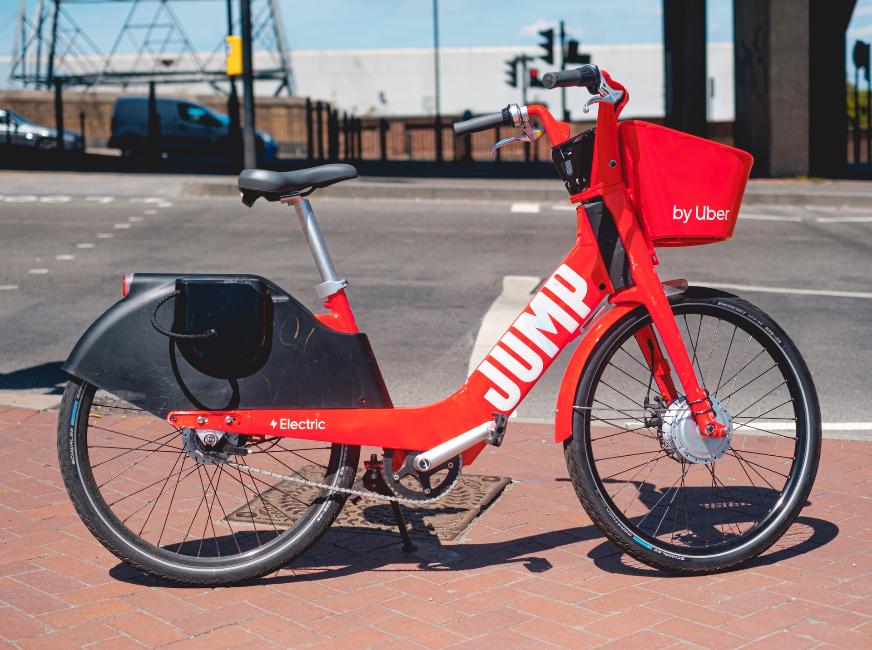
Photo Courtesy: Ehimetalor Akhere Unuabona/Unsplash
Depending on where you live, purchasing a car is out of reach or impractical. If you live in LA and drive to work, you’re familiar with the slow-moving highway traffic and frequent accidents that make commuting even slower.
On top of that, you need to spend time looking for parking in a busy area. Often, it’s more cost-effective and less stressful to take a bus or walk because you save money on gas and don’t need to find a space to park.
Even though public transport solves most of these problems, busses run on their own schedule, only drop you off at key locations, and are often crowded and unsanitary. Now, you have no control over your trip, and it may take a large chunk of time out of your day to catch the bus.
An e-bike or e-scooter solves all of your problems, and in many cases, they are better for travel than trains, buses, or cars. A folding scooter or bike doesn’t even need a parking spot – you can just bring it with you while you shop or place it under your desk at work.
Can’t a Human Powered Bike or Scooter do the Same Thing?
Absolutely. A human-powered scooter or bike can take you where you need to go and are a practical means of transportation. They also give you a cost-effective method of exercise and are an eco-friendly option that most people can use daily.
However, many people don’t live close to their work, or they don’t have the physical fitness or capability to bike for miles a day. Even for those who are capable of biking long-distances, you will almost always arrive a sweaty mess.
An electric bike or scooter is accessible for all ages, fitness levels, and physical capabilities because the motor provides additional support for longer or harder commutes. You won’t find yourself stranded if you can’t pedal or kick your analog vehicle long distances.
E-Bikes vs. E-Scooters
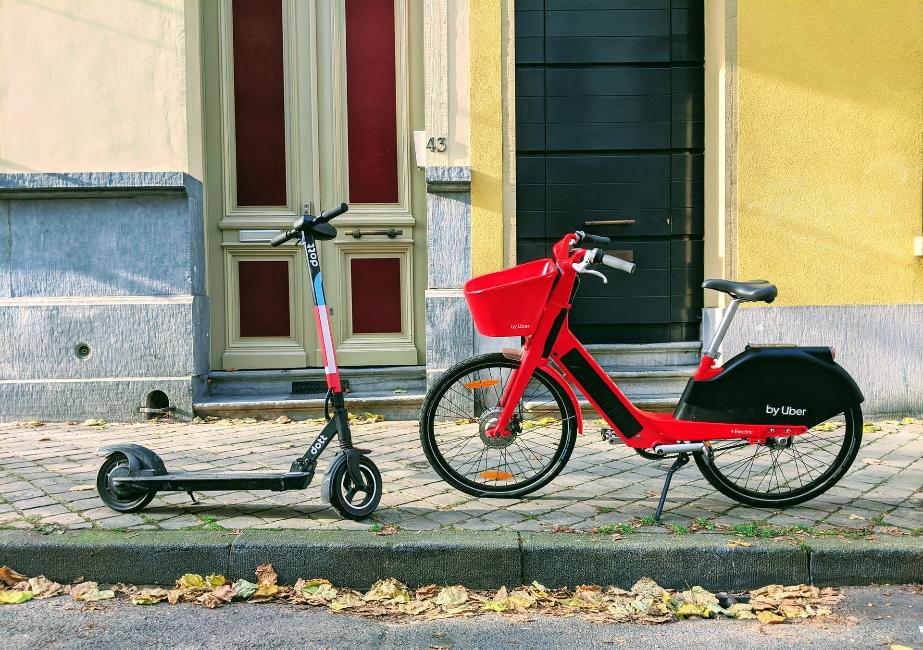
Photo Courtesy: Lucian Alexe/Unsplash
There is some confusion surrounding e-bikes and e-scooters. Even though both bikes are 2-wheeled, they feel different when you ride them, and their legal requirements, mileages, and benefits vary greatly.
Electric Bikes
Electric bikes are 2 wheeled bicycles that come outfitted with functional pedals – usually. Some e-bikes won’t come with pedals, but those are usually models that are small, less than $500, or aren’t fitted initially because they come at an added price.
Even though e-bikes look similar to human-powered bicycles, they have motors planted on the frame. Typical places to find the motor vary on model and manufacturer, but a rear hub motor, front hub motor, or center hub motor are common.
E-bikes will also have a battery to power the motor, a drive train to turn the power generated to propel the bike forward, and a throttle to manage and change speeds. Otherwise, an electric bike has the same parts and components as a regular bicycle.
Pedal assisted e-bikes give your bike an extra boost while pedaling, and some models require you to pedal to start the motor. While some e-bikes will need physical effort to maintain speeds, others will either make pedaling optional or will be 100% motor functionality.
Electric Scooters
Electric scooters are a two-wheeled vehicle that differs from a skateboard because it has handlebars. In comparison to an analog scooter, the e-scooter will have a motor and is self-propelled after the users’ initial kick-off from the pavement.
The powerful accumulator can help you overcome a more considerable distance than what may have been capable of a human-powered scooter. You also won’t have to push off the ground to keep momentum continuously – you just have to use the throttles on the handlebars to maintain speeds.
Some e-scooters will include a seat that makes them more similar to a moped than a scooter, but the seat can add extra comfort for anyone who doesn’t want to stand for long distances. E-scooters with seats are more expensive than standing versions.
Since e-scooters never come with pedals, there aren’t pedal-assisted scooters. If you want to go faster, you could kick on the ground – but you’ll probably hurt yourself. E-scooters aren’t for people who wish to exercise during their commute.
Legal Requirements
The United States has confusing laws when it comes to understanding what a street-legal electric scooter is. This is because the US federal law governing electric bikes also applies to electric scooters as well.
Electric Bikes
US2002 Federal Law states that an electric bike will become street legal if it has a top speed of less than 20 mph (32 km/h), and the motor power is below 750W. However, because most states don’t follow this law, or have implemented a Class system for bikes, this isn’t always true.
The chart below shows legal bike speeds (20 mph – 28 mph) and illegal speeds (35mph or higher). It’s possible to rig an e-bike to go faster than what’s listed on this chart, but it won’t be road legal.
| Battery + Motor (Flat Terrain 165 lbs Male) | Max Speed | Average E-Bike Cost | Average Charge Time |
| 250w | 20 mph (32.19 km/h) | $500 – $1000 | 20 minutes |
| 500w | 25 mph (40.23 km/h) | $750 – $1250 | 40 minutes |
| 750w | 28 mph (45 km/h) | $750 – $1500 | 60 minutes |
| 1000w | 35 mph (56.32 km/h) | $1000 – $1500 | 80 minutes |
| 1500w | 40 mph (64 km/h) | $1500 – $2000+ | 120 minutes |
The 3-Class System
Here is a breakdown on which e-bikes classify for Class 1, Class 2, and Class 3 under the legislation. Since 2014, the national bicycle advocacy group PeopleForBikes has helped over 30 states pass standardized regulations for e-bikes with the use of the 3-Class System.
- Class 1: Assists pedaling but not your throttle, these e-bikes are passive and are allowed to function on bike paths. Pedal-assist only (absolutely no throttle), and have a maximum assisted speed of 20 mph (32.19 km/h).
- Class 2: Known as low-speed throttle-assisted e-bikes. These e-bikes have motors that proper the cyclist without pedaling. The rider cannot exceed more than 20 mph (32.19 km/h) like Class 1, accept Class 2 e-bikes must be throttle-assisted.
- Class 3: Known as speed pedal-assisted electric bikes and provide assistance to the rider if they’re pedaling. Cannot have a throttle. Class 3 e-bikes can have a maximum assisted speed of 28 mph (45 km/h). However, the US only allows bikes on the road that have a maximum of 20 mph (32.19 km/h).
All e-bikes, no matter the Class, limit the motor’s power to 1 horsepower (750W). Be aware that the class system is specific to e-bikes, whereas e-scooters have their own system in place that is similar, but not the same.
Electric Scooters
In the United States, electric scooters are allowed on roads that lack bicycle lanes as long as they don’t exceed speed limits of 25 mph (40 km/h). Similar to e-bike regulations, this varies based on state. E-scooters are sometimes their own category but are usually treated as e-bikes.
California, for example, uses the classification of Personal Light Electric Vehicles and can ride on pavements, roads, and cycle lanes as long as you’re over the age of 16 and are wearing a helmet. However, in San Francisco, it’s illegal to leave your power scooter unattended.
E-scooters don’t require a license to operate, although some US states do require one if you want to operate an e-bike. Always check your local laws before operating either electric vehicles to ensure you aren’t breaking any state laws.
Overall, it’s easier to own an e-scooter because less licensing is needed to operate one, and you are less likely to break any laws. Just ensure that you wear a helmet with an e-scooter and follow traffic rules in your state to avoid a ticket.
Price Comparison
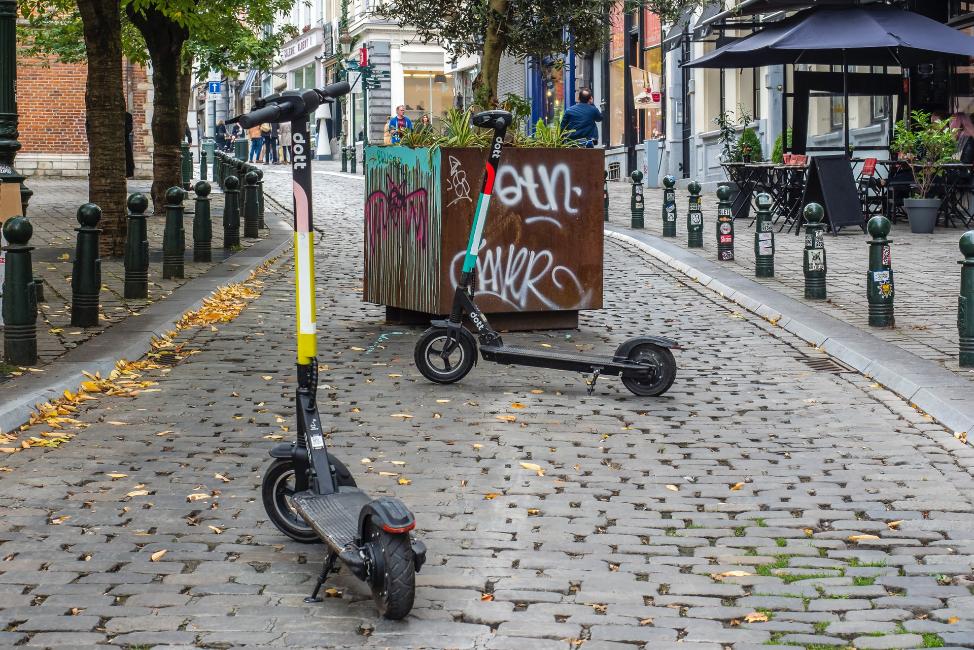
Photo Courtesy: Alexander Schimmeck/Unsplash
On average, e-bikes are more expensive than scooters on the initial purchase, but in general, electric-powered vehicles are cheaper than gas-powered ones. When compared, electric scooters and electric bikes generally have a lower running cost than gas-powered vehicles.
A 5 km (3 miles)ride will only cost you 5 cents in electricity, whereas gas can cost upwards to a dollar per 4km (2.5 miles). However, calculating the cost of the vehicle doesn’t just start and end when you buy the product. You also need to factor in the maintenance and quality of the e-vehicle.
Both the range of the prices for electric bikes can start low (less than or equal to $500), they can sky-rocket as their specifications increase. Due to the popularity of e-bikes, it’s likely the e-bikes will become cheaper as the parts become cheaper to produce.
Even though an e-scooter is cheaper initially, electric bikes are cheaper to maintain if you don’t have expertise in electric vehicles. Maintaining your e-bike is more convenient than e-scooters are because more mechanics know how to service their parts.
E-bikes have one significant value advantage: you can electrify most regular bikes. E-scooters don’t have conversion kits readily available, but e-bikes do. For example, a conversion kit like Swytch can quickly turn any human-powered bike into a motor-powered one.
In general, higher-priced e-bikes or e-scooters will provide a better range, higher speeds, and are made of higher quality material. Paying more for an e-vehicle also translates to lighter weights rather than a jump in raw power once pricing exceeds $1000.
Portability Comparison
Unless you have a scooter that’s as big as a moped, e-scooters are almost always more portable than e-bikes. Most scooters are tested to fit in a trunk or sedan and are allowed on public transportation and Ubers. E-bikes are often too big for most cars.
E-scooters are also lighter than e-bikes because there are fewer components on the scooter itself. A scooter is basically 2 long pieces of metal, 2 wheels, and 2 handles. An e-bike has more complicated machinery and is usually heavier and has a bulkier frame.
Few e-bikes weight less than 40 lbs (18 kg), and only a few expensive (over $1500) e-bikes will weigh less than 30 lbs (13 kg). More affordable models will run you higher than 60 lbs (27 kg). However, e-scooters average 30 to 50 lbs (13 kg to 22 kg).
These comparisons are not a hard and fast rule – some e-scooters and e-bikes are small enough to fit in suitcases. Overall, scooters are usually less expensive, smaller, and more portable, whereas e-bikes can be bulky, heavy, and may not always bend in half.
Range Comparison

Photo Courtesy: Galen Crout/Unsplash
E-bikes have better ranges than e-scooters – period. It’s rare to see an e-scooter go beyond 40 miles (64 km) on a single charge, but many e-bikes will go at least 70 to 120 miles (113 to 193 km). On top of that, e-bikes can go farther – at a lower price.
Unfortunately, once your e-scooter runs out of juice, you’ll need to kick the ground to get moving again. However, it’s harder to do so because the scooter is incredibly heavy. An e-bike has a pedal assist and constant momentum, which makes pedaling an e-bike effortless.
Still, if your battery does run out of the scooter, you can always call a cab because they can fit in the trunk. With an e-bike, you’ll have no choice but to power it yourself because most Ubers and taxis won’t let you store a bicycle in a car.
Exercise Comparison
If you want to use your mode of transportation as an exercise device – don’t pick an e-scooter. Sure, you can push the scooter along, but it won’t provide you the type of full-body exercise that a pedantic e-bike can.
Riding an e-bike gives you the option of a serious workout, and more often than not, e-bike riders get more exercise the cyclists. E-bike riders tend to make longer commutes, which usually involves pedaling to either get to the destination faster or because the option to exercise is already there.
Lugging a 70 lbs (31 kg) e-bike up a hill with the assist turned off will give you quite the workout and will undoubtedly activate your quadriceps. An e-scooter can’t do that; it would actually be safer and faster to walk up a hill while bench pressing a piece of metal.
Speed Comparison
Both the e-scooter and e-bike are capable of speeds faster than their human-powered equivalents. In the Legal Requirements section, we governed the regulations of e-bikes compared to e-scooters, where e-bikes are more regulated based on speeds.
In the US, e-bikes cannot exceed 20 mph (32 km/h) in most cases. Since US laws differ from state to state, it’s better to research each individual state before using an e-bike that may exceed 28 mph (45 km/h), which is the legal limit is some states.
E-scooter have mostly unenforced or ambivalent laws. You are unlikely to get stopped by the police for speeding on an e-scooter in a bike lane or on the road. It’s bizarre because it’s easy to buy or rig e-scooters to exceed 40 mph (64 km/h).
Technically, e-scooters can go faster because they’re legally allowed to. Plus, e-scooter are more compact, meaning you can either carry them around with you or in a backpack, which saves you time. Locking up your bike takes extra time and more security precautions.
Utility Comparison
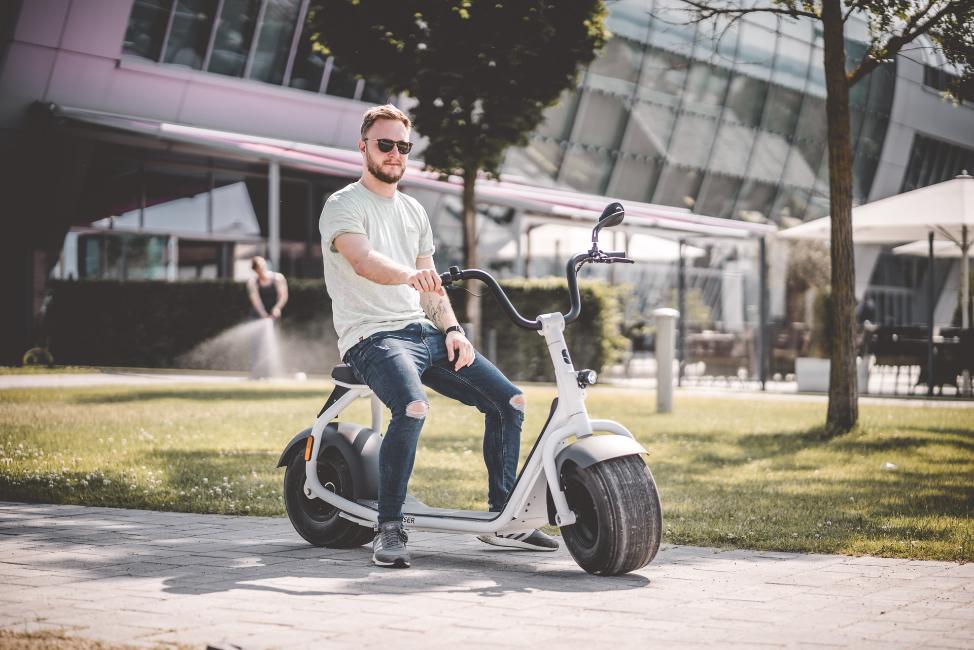
Photo Courtesy: Kumpan Electric/Unsplash
While e-scooters excel in portability, e-bikes are perfect for extra cargo and are capable of holding multiple add-ons. It’s possible to attach baskets on the front and back of cargo e-bikes for grocery trips or to haul your projects to and from work.
Even if your e-bike isn’t meant to hold cargo, you can equip your regular city or commuter e-bike with trailers, rockets, baskets or panniers. E-scooters simply don’t have the space or stability for a large amount of cargo or add-on accessories.
Safety Comparison
It’s difficult to compare safety on the e-scooter or e-bike because they’re only as safe as the operator is at handling them. Safety can vary tremendously based on the make, model, and type of electric vehicle you’re riding.
E-bikes have bigger wheels that can travel over potholes and debris without the fear of bouncing too high or off the seat. These tires can also navigate wet weather, and the heavier frames offer more stability. E-bikes are also more visible on the road.
An e-scooter, however, makes you more agile so you can quickly navigate around pedestrians or cars. You can hop off the scooter if necessary to avoid a severe accident, which is more challenging to do on an e-bike – especially with the motor or battery in the way.
On average, there are more accidents from e-scooter than there are from e-bikes, and it’s likely because of the lack of regulations. Still, e-scooters have larger tires and a better suspension, so day to day use is more comfortable and accessible than on an e-bike.
Another recent study shows that e-bikes have a distinct pattern of severe injuries that result in hospitalization. Overall, e-bikes result in fewer accidents, but the accidents are more severe, whereas e-scooter users are more likely to have accidents that aren’t life-threatening.
Always wear a helmet. Wearing a helmet can reduce many injuries, especially injuries involving the head, neck, and shoulders. If you happen to fly off your e-bike or e-scooter, you can save yourself from a severe concussion or brain injury.
Durability
E-bikes have more direct support if they have a flat tire, a bent spoke, or need general maintenance. E-scooters don’t have the same accessibility because they are less prevalent than e-bikes, so many mechanics aren’t knowledgable on e-scooter components.
To make matters worse, e-scooters aren’t as durable as e-bikes. E-bike manufacturers have the 200-year history of bicycle maintenance under their belt, as well as the decades of knowledge-based around servicing e-bike specific components.
If you want at least a 15-year relationship with your electric vehicle, opt for an e-bike. They’ll often last longer, have better parts, and maintenance is easier. If you own an e-scooter, you will need to learn a lot of maintenance tips yourself.
Are you an e-bike or an e-scooter enthusiast?
Are you interested in many other articles, like this one, that gives in-depth information about different e-bikes and e-scooters?
Visit our website for more information on the best electric bikes and scooters that can make your commute more stylish and fun.
Before you go, leave a comment on your preference – do you like e-bikes or e-scooters more?
Be sure to read one of our other articles about the history of bicycles and e-bikes while you’re at it!
The post Should I Buy an Electric Bike or an Electric Scooter? appeared first on eRide Guides.
]]>